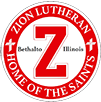7th Grade Curriculum
Seventh Grade Curriculum
Religion: We utilize the Concordia Publishing House series of One in Christ, Level 7.
Students have weekly memory work assignments in which they learn a variety of Bible passages. This curriculum has been designed so that through the Word and Spirit of God, students of all abilities work through and study these units
- God and His Word
- The Holy Spirit Blesses the Church: The Third Article
- God the Father’s Gracious Gifts: The First Article
- Jesus Brings Salvation: The Second Article
- God Hears and Answers His People: The Lord’s Prayer
- Worship: In Liturgy and Life
- God Comes to Us Through the Means of Grace
- The Ten Commandments
- Witnessing: Faith for Life
Students also have twice weekly Confirmation lessons and memory assignments which focus on the Small Catechism and Old Testament themes.
Literature: We use the series Collections by Houghton Mifflin Harcourt. This series is a combination of on-line and textbook lessons. The lessons come from short stories, poems, graphic novel segments, novels and short research projects. Students will practice Close reading, finding context clues, reading for understanding and uses of figurative language.
English: We use Glencoe McGraw-Hill Writer’s Choice Grammar and Composition for the structure of the year. Seventh graders apply writing and grammar skills including parts of speech, sentence types, capitalization, punctuation, speaking and listening. Students recognize and use simple, complex and compound sentences in weekly journal assignments. They recognize and use standard editing symbols in numerous written projects. This year we are not using the textbook. Instead we are utilizing the grammar portion of our Literature textbook, I also supplement with “Classroom Cereal” and other online editing review sheets.
Spelling and Vocabulary: Spelling words are taken from the stories taken out of the Literature series Collections and novels that are read in class. In google classroom, students weekly define twenty specific words and use them in a sentence that matches how the word was used in the given story. Students take weekly Spelling tests.
Mathematics: At the beginning of 7th grade, students that have a high math aptitude, have done well in 6th grade math, and do well on math MAPS tests, have the option of advancing to the 8th grade Pre-Algebra class. Please see the 8th grade curriculum for more information on that class.
7th grade math uses Big Ideas Math: Modeling Real Life. The course emphasizes a narrower and deeper curriculum, ensuring students spend their time on the major topics which include ratio and proportional relationships, the number system, expressions and equations. It uses a balance of procedural fluency, conceptual understanding and real-life applications to further the students education.
8th grade math: Modeling Real Life by Big Ideas Math is the Pre-Algebra book used for 8th grade. This is a transitional math book designed to help students move from the concrete concepts of arithmetic to the abstract concepts of algebra. Primary topics include: equations, transformations, angles and triangles, graphing and writing linear equations, systems of linear equations, data analysis and displays, functions, exponents and scientific notation, real numbers and the pythagorean theorem, volume and similar solids.
Science: The students use the curriculum from Kesler Science. The 7th & 8th graders alternate their yearly topics between Life Science and Physical Science. The Life Science curriculum is made up of three main sections: Structure of Life, Body Systems and Interactions in an Ecosystem. The Physical Science curriculum focuses on Force & Motion, Chemistry, and Energy.
Geography: The students use the textbook National Geographic: World Cultures and Geography by Cengage/National Geographic. With this textbook the students study in great detail the seven continents. The class is subdivided into Physical Geography, Human Geography, and Regional Geography. Students use and make many maps with the class.
Art: Seventh graders have Art instruction once a week. The focus of the program is to use the Art Attack video series . This is a series of DVD’s that highlight the elements of art and famous artists. Students watch a presentation of an art project and then create their own. The projects highlight form, composition, color, texture and line
Physical Education: Students participate in two 30 minute class periods per week, focusing on overall physical fitness and stressing the areas of teamwork, Christian sportsmanship, skill building, and lifelong fitness. Students are given the FitnessGram fitness assessments in the spring of every year and are encouraged to compare to previous years’ scores for growth.
Computer Science: Students have two 30 minute Computer Science class periods per week. Focused units include: computer terminology, digital citizenship, Lego Mindstorm Robotics, and online coding with Scratch. Students are each issued an Asus Chromebook that is used daily for every class, with Google Classroom as our learning platform. Students use Google Apps for Education on a daily basis.
Music: Students have three choices for their middle school music class. They can choose to do 2 or 3 of them. The choices are below.
Choir: Students sing in parts and as a whole. They learn a wide variety of songs and hymns, and join in Zion Lutheran Church Sunday worship services.
Music Class: We use Hal Leonard’s Essential Elements Music Class Curriculum. Our music curriculum focuses on grade leveled music concepts, standards, and SEL competencies. Each lesson has supporting songs and resources delivered in a flexible and adaptable format.
Band: Band students have a small group class with the band director for 20 minutes a week, and a large group band time with all of the 6-8th graders in band for 40 minutes a week.
Spanish: Students use Duolingo to guide them through learning the Spanish language. There are many different topics and levels available to them. They also get to use Blookets to help them learn Spanish vocabulary.
